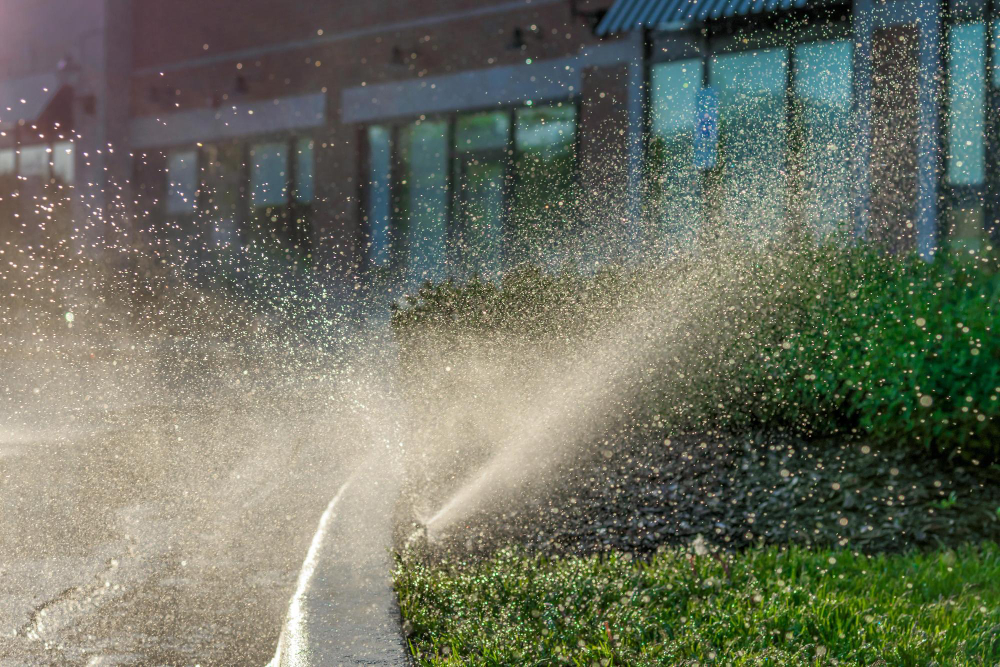Essential Watering Tips for Commercial Landscaping in Hot Weather

When it comes to maintaining lush, vibrant landscapes in Sanford, FL, the sweltering heat can pose a significant challenge. Commercial properties, in particular, face the daunting task of keeping their landscapes healthy and appealing in the face of extreme temperatures. Effective watering strategies are crucial to ensure that your commercial landscaping not only survives but thrives during the hot months. Here’s a comprehensive guide to help you do just that, with insights tailored for Sanford’s unique climate.
Understanding Sanford’s Climate
Sanford, Florida, is known for its hot, humid subtropical climate, characterized by long, hot summers and relatively mild winters. During the peak summer months, temperatures can soar, and humidity levels can be high. This climate presents specific challenges for landscaping, making effective watering practices essential.
The Importance of Proper Watering
Proper watering is the lifeline of any landscape, especially in a commercial setting where aesthetics play a vital role in creating a positive impression on visitors and clients. Overwatering or underwatering can lead to issues such as root rot, fungal diseases, and wilting, which can diminish the curb appeal and health of your landscape.
Benefits of Adequate Watering
- Healthy Growth: Ensures robust plant growth and development.
- Disease Prevention: Reduces the risk of diseases caused by over-saturated soil.
- Water Conservation: Helps conserve water by using it efficiently.
Optimal Watering Techniques for Hot Weather
1. Water Early in the Day
Watering your landscape in the early morning, preferably before 9 a.m., is one of the most effective ways to minimize water loss due to evaporation. This timing allows the water to soak into the soil and reach the roots before the sun gets too intense.
2. Focus on Deep Watering
Deep watering encourages strong root systems by ensuring that water penetrates the soil to a significant depth. Aim to water to a depth of about 6-8 inches. This encourages roots to grow deeper into the soil, making plants more drought-resistant.
3. Use Mulch to Your Advantage
Mulching is an excellent technique for conserving moisture in the soil. Apply a 2-3 inch layer of organic mulch around the base of plants. Mulch helps reduce evaporation, suppress weeds, and maintain a consistent soil temperature.
4. Install a Drip Irrigation System
Consider installing a drip irrigation system for efficient water delivery. Drip systems provide water directly to the root zone, minimizing water waste and reducing the risk of foliage diseases caused by water splashing on leaves.
5. Adjust Sprinkler Systems
Ensure that sprinkler systems are adjusted to prevent unnecessary runoff and overspray onto sidewalks and driveways. Regularly check for leaks and clogs to maintain optimal performance. Smart controllers can help automate watering schedules based on weather conditions.
Selecting the Right Plants for Hot Climates
Choosing the right plants is essential for successful commercial landscaping in Sanford’s hot climate. Opt for native and drought-tolerant species that are well-adapted to local conditions. Some suitable options include:
- Florida Native Plants: Plants like Coontie, Beautyberry, and Muhly Grass are native to Florida and thrive in its climate.
- Drought-Tolerant Varieties: Consider plants like Lantana, Agave, and Yucca, which require less water and maintenance.
Signs of Water Stress in Plants
Recognizing the signs of water stress is crucial for timely intervention. Keep an eye out for the following indicators:
- Wilting: Leaves that droop or curl indicate water deficiency.
- Yellowing Leaves: Indicates inadequate watering or nutrient imbalance.
- Leaf Drop: Sudden leaf loss may signal stress due to lack of water.
Common Mistakes to Avoid
In the pursuit of maintaining a healthy landscape, certain common mistakes should be avoided:
- Overwatering: Leads to root rot and other fungal diseases.
- Shallow Watering: Results in weak, shallow root systems.
- Ignoring Soil Type: Different soil types have varying water retention capacities; adjust watering accordingly.
Seeking Professional Help
While these tips provide a solid foundation for effective watering practices, enlisting the expertise of a professional landscaping company can further enhance the health and appearance of your commercial property. If you need professional commercial landscaping in Sanford, FL, contact Plant This today to schedule a consultation. Our team of experts can create a customized watering plan tailored to your specific landscape needs, ensuring its beauty and health year-round.
Conclusion
Maintaining a vibrant commercial landscape in Sanford, FL, requires strategic watering techniques that accommodate local climate conditions. By implementing these essential watering tips, you can safeguard your landscape against the challenges posed by hot weather. Remember, the key lies in watering efficiently, selecting suitable plants, and seeking professional guidance when needed. With the right approach, your commercial property can remain a beacon of beauty, even in the hottest months.
For personalized advice and expert assistance, don’t hesitate to reach out to Plant This. Our commitment to excellence in commercial landscaping ensures that your property remains stunning and inviting throughout the year. Contact us today to learn more about our services and how we can help your landscape thrive.